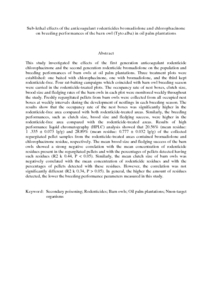Citation
Salim, Hasber and Mohd Noor, Hafidzi and Omar, Dzolkhifli and Hamid, Noor Hisham and Zainal Abidin, Mohd Rizuan and Kasim, Azhar and Md Rawi, Che Salmah and Ahmad, Abu Hassan
(2014)
Sub-lethal effects of the anticoagulant rodenticides bromadiolone and chlorophacinone on breeding performances of the barn owl (Tyto alba) in oil palm plantations.
Slovak Raptor Journal, 8 (2).
pp. 113-122.
ISSN 1338-7227
Abstract
This study investigated the effects of the first generation anticoagulant rodenticide chlorophacinone and the second generation rodenticide bromadiolone on the population and breeding performances of barn owls at oil palm plantations. Three treatment plots were established: one baited with chlorophacinone, one with bromadiolone, and the third kept rodenticide-free. Four rat-baiting campaigns which coincided with barn owl breeding season were carried in the rodenticide-treated plots. The occupancy rate of nest boxes, clutch size, brood size and fledging rates of the barn owls in each plot were monitored weekly throughout the study. Freshly regurgitated pellets from barn owls were collected from all occupied nest boxes at weekly intervals during the development of nestlings in each breeding season. The results show that the occupancy rate of the nest boxes was significantly higher in the rodenticide-free area compared with both rodenticide-treated areas. Similarly, the breeding performances, such as clutch size, brood size and fledging success, were higher in the rodenticide-free area compared with the rodenticide-treated areas. Results of high performance liquid chromatography (HPLC) analysis showed that 20.56% (mean residue: 1 .335 ± 0.073 lg/g) and 28.89% (mean residue: 0.777 ± 0.032 lg/g) of the collected regurgitated pellet samples from the rodenticide-treated areas contained bromadiolone and chlorophacinone residue, respectively. The mean brood size and fledging success of the barn owls showed a strong negative correlation with the mean concentration of rodenticide residues present in the regurgitated pellets and with the percentages of pellets detected having such residues (R2 k 0.44, P < 0.05). Similarly, the mean clutch size of barn owls was negatively correlated with the mean concentration of rodenticide residues and with the percentages of pellets detected with these residues. However, the correlation was not significantly different (R2 k 0.34, P > 0.05). In general, the higher the amount of residues detected, the lower the breeding performance parameters measured in this study.
Download File
![[img]](http://psasir.upm.edu.my/35524/1.hassmallThumbnailVersion/Sub-lethal%20effects%20of%20the%20anticoagulant%20rodenticides%20bromadiolone%20and%20chlorophacinone%20on%20breeding%20performances%20of%20the%20barn%20owl%20%28Tyto%20alba%29%20in%20oil%20palm%20plantations.pdf)  Preview |
|
PDF (Abstract)
Sub-lethal effects of the anticoagulant rodenticides bromadiolone and chlorophacinone on breeding performances of the barn owl (Tyto alba) in oil palm plantations.pdf
Download (85kB)
| Preview
|
|
Additional Metadata
Actions (login required)
 |
View Item |

